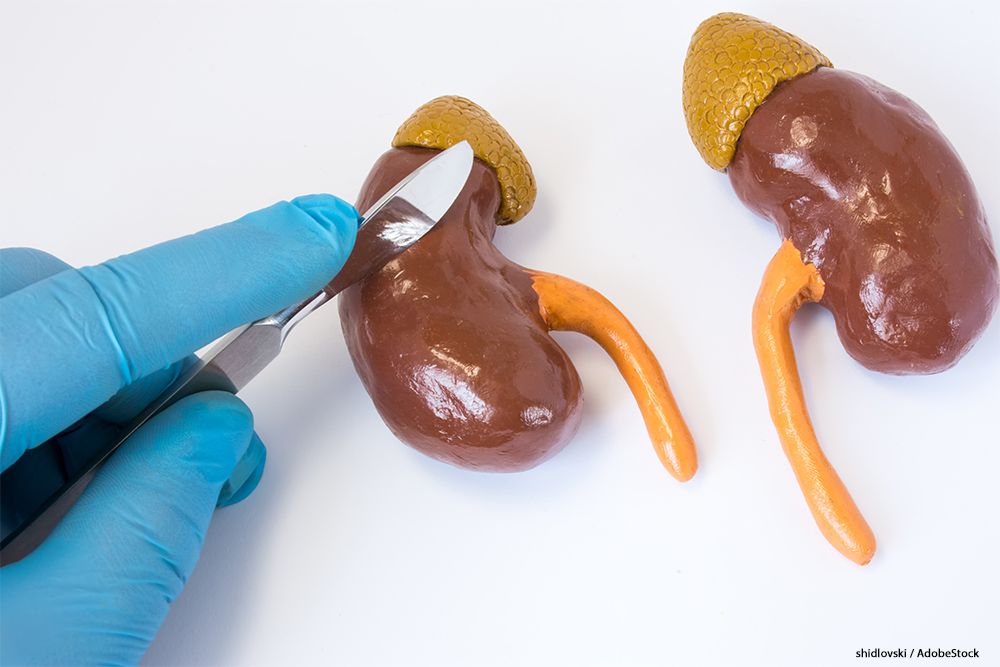Neoadjuvant Axitinib May Reduce Size of Complex Kidney Masses Enough to Permit Partial Nephrectomy in Cases of Kidney Cancer
The findings, according to the lead study author from UC San Diego School of Medicine, are a proof of concept and need to be confirmed in a phase 2 trial.
For patients with clear cell renal cell carcinoma (RCC) — a type of kidney cancer — and complex masses indicated for nephron-sparing surgery but with no viable pathway to receive the procedure, treatment with axitinib (Inlyta) may facilitate partial nephrectomy.
“Neoadjuvant axitinib seems to be successful in allowing some patients to undergo a partial nephrectomy who had previouslybeen deemed not able to undergo this procedure, and [they were able to undergo surgery] with successful preservation of renal parenchyma," said the lead study author in an interview with a sister publication of CancerNetwork®.

The findings were from interim results of the phase 2 PADRES trial, which were presented at the 2022 Society of Urologic Oncology (SUO) Annual Meeting.1
Lead author Kevin Hakimi, a medical student at the UC San Diego School of Medicine, and coauthors launched the single-arm PADRES trial (NCT03438708) to determine whether neoadjuvant therapy with the TKI axitinib could cytoreduce renal tumors and permit partial nephrectomy in circumstances not otherwise feasible.
Overall, there were 26 patients enrolled in the study. The median age was 69.5 years. Patients had biopsy-confirmed clear cell RCC strongly indicated for partial nephrectomy with the potential for dialysis dependence if given radical nephrectomy. All patients had complex renal masses, which the study defined as a RENAL Nephrometry score in the high range of 10 to 12 and a tumor stage of cT1b to cT3M0. There were 14 males and 12 females. The ECOG performance status was 0 for 9 patients, 1 for 15 patients, and 2 for 2 patients.
Patients received oral axitinib at 5 mg twice daily for 8 weeks prior to nephrectomy. The primary end point of the trial was reduction in longest tumor diameter as determined by imaging criteria. Secondary outcome measures included tumor response per RESIST criteria, feasibility of partial nephrectomy, change in RENAL Nephrometry score, survival outcomes, and post-surgical complications.
At a median follow-up of 12 months, the median reduction in tumor size was 19% (P <.001), with a median tumor size of 7.7 cm prior to axitinib treatment and 6.3 cm after. Axitinib also led to a significant reduction in median RENAL Nephrometry score from 11 to 10 (P <.001). There were 9 patients (34.6%) who had a partial response per RECIST criteria and the remaining 17 patients had stable disease.
The specific tumor staging pre- vs post-axitinib was as follows: T1a, 0 vs 5 patients, respectively; T1b, 4 vs 3 patients; T2a, 2 vs 0 patients; T3a, 17 patients each; T3b, 3 vs 1 patient.
Regarding the safety of pre-operative axitinib, 5 patients experienced grade 3 adverse events related to the treatment, consisting of hypertension (n = 3), fatigue (n = 1), and weight loss (n = 1).
Surgical outcomes showed that 25 patients were able to complete nephrectomy, comprising 19 partial nephrectomies and 6 radical nephrectomies. Twenty four (92.3%) of the patients had negative margins. There were 6 patients who had grade 3/4 post-operative complications.
In an interview with Urology Times — a sister publication of CancerNetwork®, Hakimi summarized the main takeaway from the PADRES study: “Neoadjuvant axitinib seems to be successful in allowing some patients to undergo a partial nephrectomy who had previouslybeen deemed not able to undergo this procedure, and [they were able to undergo surgery] with successful preservation of renal parenchyma. We’re still accruing patients with a target goal of 50, and then we hope to publish our results for the trial in a journal going forward.”
Looking ahead, Hakimi said, “The next steps are to see whether this indication can be explored in a double-arm phase 2 trial where we explore giving some patients neoadjuvant therapy and not giving others neoadjuvant therapy and then determining whether they can undergo complex partial nephrectomies and what their GFR is after that. But for now, this is a proof of concept and we want to see if this is actually possible and if it works in this highly complex cohort of patients.”
Reference
Hakimi K, Campbell S, Nguyen M, et al. Interim analysis of PADRES (Prior Axitinib as a Determinant of Outcome of Renal Surgery NCT03438708) clinical trial. Presented at: Society of Urologic Oncology 23rd Annual Meeting; November 30-December 2; San Diego, California. Abstract 145.